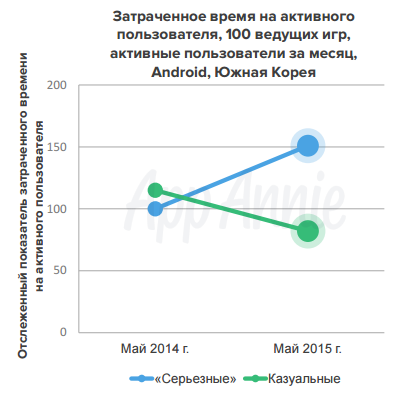App Annie analytical company summed up the results of last year by releasing (including in Russian) its retrospective report. Read about the most important thing in it in our material.

The results of the year in the mobile games market can be called ambiguous. The fact is that, on the one hand, the average life cycle of new games has fallen by 60%. In other words, earlier games reached the “estimated market potential” much slower. Accordingly, they lived longer. Now they reach a high level of downloads in a shorter time (App Annie writes that most of the games have realized their potential in 4 months), and then burn out faster. The tail of sales turns out to be shortened.
As a result, many players in the market are “focused on the release of new games”, wanting to maintain their former inertia. Here, by the way, an example comes to mind with King, which is already almost churning out more and more match-3, but it will also be fair in relation, in particular, to the Machine Zone.
On the other hand, App Annie notes that there is a drop in the concentration of income in the hands of market leaders. The money is more evenly distributed across the top. However, it seems to us that we are talking primarily about the erosion of income between the first hundred cash applications. There was no money for the Top 100, and it is unlikely to be (at least, more or less noticeable, capable of recouping expensive development and marketing).
Of the most important in the mobile games market, analysts also highlight the growing importance of hardcore games with a “high level of engagement”. The main trendsetter here is still the Asian region. “In 2015, half of the ten highest—grossing games in South Korea were action role-playing, and half of the highest-grossing games in China were massively multiplayer online role-playing games,” App Annie reports.
Important: it’s not just about dominating the cash segment. Similar games in the East are now being conducted by MAU. In particular, according to the total time spent by active users of South Korea, hardcore games overtake casual ones.
At the end of the report, App Annie shared information about the market leaders for the year.
The most downloaded game of the year was Subway Surfers. It’s curious, but there are a lot of runners in this top in general. This is, of course, about Despicable Me and Temple Run 2. At the same time, we note that now this genre on mobile platforms, let’s say, has subsided.
EA has overtaken everyone in the world in terms of total downloads. Considering the large number of applications, as well as several successful releases on famous franchises, including Need for Speed: No Limits, this is natural.
Clash of Clans earned the most money among the games. But there are also names in the top that, most likely, do not mean anything to you (as well as to us). It’s worth taking a closer look. We are now, in particular, talking about the Chinese MMORPG Fantasy Westward Journey, as well as the role-playing action Colopl Rune Story from Colopl.
Among gaming companies, Supercell earned the most money in the mobile market during the year. Of the top ten gross companies, attention, 6 are Asian.
According to MAU on iOS, Candy Crush Saga is among the leading games. Also in the top of those that are not constantly “on the ear”: Trivia Crack, 8 Ball Pool and the old lady Words With Friends.
It is curious that the world MAU-top on Android is very similar to iOS. But here I would like to mention Hill Climb Racing.
The last two tops clearly demonstrate what people really play in the world on mobile. Massively.
Among other things, the App Annie report notes more boring information concerning the entire market.
In particular, the number of downloads from Google Play has increased by 100% over the year. The main drivers of growth were Brazil, India, Indonesia, Turkey and Mexico. The number of downloads from the App Store, in turn, almost did not grow.
Despite the previous level of downloads, revenues from the App Store have grown significantly in 12 months. For this, it is worth saying thanks to China, the USA and Japan. Google Play’s revenues have also increased significantly, but this year their lag behind the App Store’s profits turned out to be greater compared to the results of 2014.
On both platforms, most of the money comes from the games market. On Google Play, they generate 90% of the platform’s revenue, on iOS – 75%.
It is important that China generates more downloads on iOS than the USA. The Celestial Empire still earns less money, but given the rate of income growth, it is possible that next year China will earn more on iOS applications than the current leaders – Japan and the United States.
App Annie notes that 95% of the money generated by Chinese iOS users comes from games. They like to play in China.
The full 72-page App Annie report in Russian can be downloaded here.










